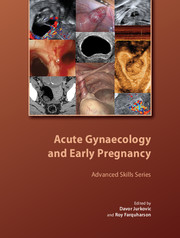Book contents
- Frontmatter
- Contents
- About the authors
- Acknowledgements
- Abbreviations
- Preface
- 1 Organisation and delivery of emergency care in early pregnancy and acute gynaecology
- 2 Epidemiology and aetiology of miscarriage and ectopic pregnancy
- 3 Diagnosis of miscarriage
- 4 Conservative and surgical management of miscarriage
- 5 Management of hyperemesis gravidarum
- 6 Diagnosis and treatment of recurrent miscarriage
- 7 Differential diagnosis and management of molar pregnancy
- 8 Drugs in early pregnancy
- 9 Diagnosis of tubal ectopic pregnancy
- 10 Conservative management of tubal ectopic pregnancy
- 11 Surgical management of tubal ectopic pregnancy
- 12 Diagnosis and management of non-tubal ectopic pregnancy
- 13 Diagnosis and management of acute pelvic pain
- 14 Management of vaginal bleeding in the acute clinical setting
- 15 Current concepts in screening and outpatient management of pelvic inflammatory disease
- 16 Diagnosis and management of haemorrhagic and septic shock
- 17 Role of minimally invasive surgery in acute gynaecology
- Index
11 - Surgical management of tubal ectopic pregnancy
Published online by Cambridge University Press: 05 July 2014
- Frontmatter
- Contents
- About the authors
- Acknowledgements
- Abbreviations
- Preface
- 1 Organisation and delivery of emergency care in early pregnancy and acute gynaecology
- 2 Epidemiology and aetiology of miscarriage and ectopic pregnancy
- 3 Diagnosis of miscarriage
- 4 Conservative and surgical management of miscarriage
- 5 Management of hyperemesis gravidarum
- 6 Diagnosis and treatment of recurrent miscarriage
- 7 Differential diagnosis and management of molar pregnancy
- 8 Drugs in early pregnancy
- 9 Diagnosis of tubal ectopic pregnancy
- 10 Conservative management of tubal ectopic pregnancy
- 11 Surgical management of tubal ectopic pregnancy
- 12 Diagnosis and management of non-tubal ectopic pregnancy
- 13 Diagnosis and management of acute pelvic pain
- 14 Management of vaginal bleeding in the acute clinical setting
- 15 Current concepts in screening and outpatient management of pelvic inflammatory disease
- 16 Diagnosis and management of haemorrhagic and septic shock
- 17 Role of minimally invasive surgery in acute gynaecology
- Index
Summary
Introduction
Tubal ectopic pregnancies have historically been treated by laparotomy, with removal of the affected tube considered the definitive treatment. This remains the preferred option in cases complicated by major intraperitoneal bleeding and haemorrhagic shock. However, owing to the wide availability of transvaginal ultrasound and sensitive urine pregnancy tests, nowadays most tubal ectopic pregnancies are diagnosed in women who are haemodynamically stable with minimal clinical symptoms. This has led to the introduction of less invasive options for the surgical treatment of tubal ectopic pregnancies. This chapter reviews current strategies for surgical treatment of tubal ectopic pregnancy, focusing on the advantages and disadvantages of the various approaches.
Indications for surgical treatment of tubal ectopic pregnancy
Laparoscopic surgery has evolved from being a main diagnostic to a primary treatment modality as a result of the improved accuracy of non-invasive diagnosis of tubal ectopic pregnancy. In women with a confirmed diagnosis of tubal ectopic pregnancy, the following are the indications for surgical treatment:
• woman who is haemodynamically unstable or evidence of significant intraperitoneal bleeding on ultrasound
• viable tubal ectopic pregnancy
• significant clinical symptoms
• initial serum human chorionic gonadotrophin (hCG) over 3000 iu/ml
• failure of or non-compliance with medical or expectant management
• heterotopic pregnancy with a normal viable intrauterine gestation.
Surgery should not be delayed in women with suspected tubal pregnancy showing signs of hypovolaemic shock.
- Type
- Chapter
- Information
- Acute Gynaecology and Early Pregnancy , pp. 145 - 150Publisher: Cambridge University PressPrint publication year: 2011

